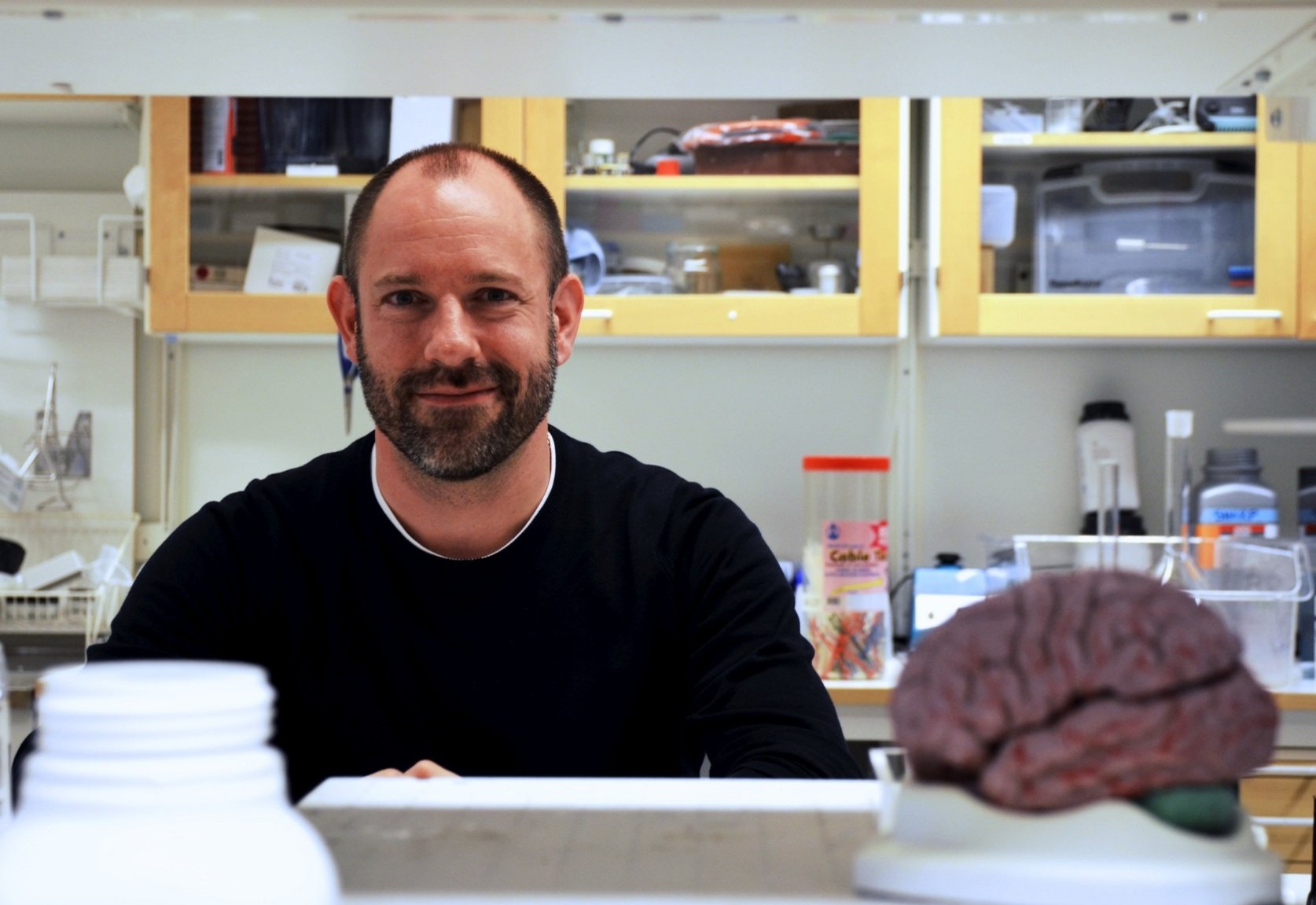When you blow a fuse
Why do some people get angrier than others in the same situation? And why do some people go far beyond the social boundaries, causing harm to others and to themselves? There are no simple answers – but we have talked to some of the people who know the most about the issue.

Text: Annika Lund, first published in Swedish in the magazine Medicinsk Vetenskap no 4 2018
BLISTERING BARNACLES, thundering typhoons!! Pickled herrings! Lily-livered landlubbers! Miserable molecule of mildew! Captain Haddock’s colourful tirades have become comic book history, with his fits of rage causing quite a bit of trouble for himself as well as his friends.
At the same time, these outbursts often save both Captain Haddock and Tintin in a pinch, because they make others back down. And this is an important aspect of aggression according to Christian Broberger, Professor at Stockholm University and affiliated researcher at the Department of Neuroscience, Karolinska Institutet.**
“You shouldn’t think of aggression as something that is only problematic and which has no place in modern society. We use aggression on a daily basis to attain different objectives. It is part of our normal behaviour, and we use it to defend ourselves from others or protect something that is important to us,” he says.
He gives a number of examples of small everyday confrontations – everything from glaring at someone on a crowded bus to escalating the tone in an e-mail conversation to standing up for something that you feel is important. But even if this is such a natural part of our lives, there is no clear or generally accepted definition.
Should you be forced to express the lowest common denominator, most people seem to agree that aggression is a clearly confrontational behaviour used in order to gain or obtain something that you want. Anger is not a prerequisite according to Christian Broberger.
“On the contrary, I would say that if you are able to achieve an aggressive behaviour without being angry, then you have an advantage, as it means that you are not emotional, but capable of making rational decisions. If your goal is to gain the upper hand in a situation or to get a job, then it might be better to focus on what your opponent is doing and what they are likely thinking. I’m not saying that aggression without anger is a better or worse type of aggression – I’m just saying that it will probably be more effective if you are trying to achieve something.”
Get along or start fighting
In his research, Christian Broberger has studied mice using a well-established model in which a mouse in a cage suddenly receives a visit from an intruder. The mice will either get along or start fighting according to well-known patterns.
Two adult males will very likely come to a confrontation, also according to a known pattern: first they sniff each other, then stand up on their hind legs, then they begin to attack each other’s paws and backs. As soon as one of them gives up, the other has established its dominance in the cage.
Christian Broberger and his colleagues have discovered that this aggressive behaviour can be controlled by manipulating specific nerve cells in the brain using optogenetics, a method that allows the stimulation or inhibition of single cells in a live animal in real time.
By inhibiting the cells, the researchers were able to avert an impending attack. They could also interrupt an ongoing attack – the mouse that was being controlled by the researchers would stop dead in its tracks and instead slink off to a corner of the cage.

And conversely, the mice could be made aggressive in situations where it was not expected, such as when the intruder mouse had been castrated. Mice judge each other largely based on chemical signal substances, i.e. pheromones, and a mouse without testosterone is not seen as a threat. But when the researchers stimulated the cells, it prompted a full-on attack against the castrated mouse. In other words, the cells involved, called PMv-DAT cells, act as some form of aggression switch.
There are more cells that may have this role. Already in 2010, an American research team found nerve cells with the same function in a different part of the brain.
“These cells and the PMv-DAT cells form links of the same chain, in which we believe that the PMv-DAT cells are activated at an early stage and recruit other parts of the brain to initiate and organise a successful attack. On the other hand, we do not know much about how the actual PMv-DAT cells are triggered or which signals control them.
Detailed neurological sequence
By mapping this process, we hope to understand more about the detailed neurological sequence of events involved in an aggressive act,” says Christian Broberger.
So far, his research only relates to mice. It is hard to say to which extent the results are relevant to humans. There is an equivalent to these nerve cells in human brains, but how they work there is yet to be investigated.
One hot topic within the field is the possibility of creating a drug that could inhibit unwanted aggression. Such a drug could theoretically be based on control of the nerve cells that Christian Broberger is studying, or on the use of other findings from the growing knowledge concerning the biology of aggression, such as the discovery of different relevant genes.
But it is an ethically complex issue, according to Christian Broberger. “This concerns areas of the brain that are involved in many different basic behaviours, such as appetite and sex drive. I think it would be difficult to create a drug that only affects one behaviour without any more extensive effects. But even if we could, how would we use it? Certain aggressive behaviours are a natural part of our lives; to what extent would it be limited? This is a question that requires extensive ethical discussion,” he says.
Clinical psychology already has methods to limit unwanted aggressive behaviours. The psychological approach is that treatment is justified when the aggression causes suffering to the affected individual or to others. The treatment available is different varieties of cognitive behavioural therapy (CBT), which is effective – but not for everyone.
The reason why CBT only works for some individuals is an important question within therapy research.
Deal with aggressive behaviours
One person trying to answer it is psychologist Johan Bjureberg, researcher at the Centre for Psychiatry Research at Karolinska Institutet. Together with his colleagues, he intends to offer three different forms of online CBT to people who have sought help to deal with aggressive behaviours.
In one version, the participants will get to practice reassessing their thoughts. If for example they get worked up about something someone has said, they will practice finding different explanations for the comment – could the person have meant something completely different, which was not unkind or offensive?
In the second version, the participants will practice becoming aware of their feelings and impulses – they are to practice feeling anger and rage well up inside without acting on it, and then they are to observe what happens to that feeling if they just let it be. The third version combines the two formats.

The beauty of the study is that the researchers will be able to measure how well the participants have mastered these techniques before, during and after treatment. In the best case scenario, it will be possible to see whether it is important to practice what you are less good at in order to achieve results – and if so, which treatment works for which patient.
The researchers also hope to see if the participants first get better at what they are practicing and if this in turn leads to improved control of their aggression.
If it does, it may be possible to establish a causal relationship, which could explain when CBT is effective – and when it is not. “It is likely a result of the treatment not actually improving the ability that needs to be reinforced. If we gain a better understanding of when CBT can be expected to work and when it won’t, then we can offer a CBT treatment that better matches the individual,” says Johan Bjureberg.
He has previously done research relating to self-harming behaviours. Those studies produced several interesting findings. Among other things, they showed that individuals who harm themselves will more often also be violent against others.
The prevalence of violent acts
One of the studies conducted by his research group included more or less the entire Swedish population born between 1982 and 1998, i.e. more than 1.8 million people. They were monitored from the age of 15 over an average period of eight years, and longer for some. Using different databases, such as the National Board of Health and Welfare’s patient registers and the criminal records of the Police Authorities, they looked at the prevalence of violent acts in the lives of these young people.
It turned out that a little over 55,000 individuals, or three per cent of the studied population, had harmed themselves seriously enough to require hospital care. These individuals had more often than others also committed such serious acts of violence that it had led to a conviction in court.
However, it was also more common for individuals in this group to have an addiction or antisocial personality disorder, which also entails an increased risk of being convicted of a violent crime. But even after the researchers had adjusted the statistics accordingly, the people who showed self-harming behaviour showed a significantly higher frequency of conviction for violent crimes than the other individuals in the population – and significantly higher than people with other diagnoses, such as depression or anxiety disorders.
This was true for both genders, but especially clear among women. There was twice the risk that a woman displaying self-harming behaviour would use violence against someone else, compared to a woman in the normal population.
“These are sensitive figures which concern a group that is already stigmatised. The important thing is that we have to ask people who are aggressive towards others if they are also harming themselves – and we must ask those who harm themselves, especially women, if they are also harming others. Both behaviours should be treated. We do not know what is the cause and what is the consequence when it comes to violent behaviour and self-harming, but we need to start asking,” says Johan Bjureberg.
There has been a general idea that women tend to direct violent behaviour towards themselves, while men tend rather to act out towards others. This is to some extent a misconception. When it comes to self-harming, an increasing number of studies show that the gender distribution is relatively even. In the study mentioned above, for example, which included more than 1.8 million individuals, a little over 56 per cent of those who harmed themselves were women. In other words, close to 46 per cent were men.
On the other hand, men are overrepresented in violent crimes, i.e. in the externalised violence. According to statistics from the Swedish Prison and Probation Service, 94 per cent of Swedish prisoners in October 2017 were men, making them heavily overrepresented compared to women in terms of murder, assault and rape.
There are no simple answers to why this is the case. At least if you believe forensic psychiatrist Henning Værøy, researcher at Akershus University Hospital in Norway – and he should know, after more than 20 years working with Norwegian law enforcement. “The male sex hormone, i.e. testosterone, is usually blamed in this context, but the research is not conclusive on its importance. I would like to highlight the importance of the traditional view of masculinity when it comes to men’s violence,” says Henning Værøy.
Published a much noted study
This summer, he and his colleagues, some from Karolinska Institutet, published a much noted study in which mice were given injections of antibodies from the blood of convicted violent offenders. The mice were then subjected to the same established aggression test as described above, where an intruder mouse is placed in a cage in which another mouse is already living.
Mice that had been injected with the antibodies of violent offenders were quicker to attack the intruder than other mice.
The injected antibodies bind adrenocorticotropic hormone (ACTH), a pituitary hormone which stimulates the adrenal glands to release the stress hormone cortisol. Of the sixteen violent offenders who had provided blood samples for the study, eleven had been convicted of murder.
Their antibodies had a stronger capacity to bond with ACTH, which stimulated an increased excretion of the stress hormone. This leads to a more forceful physical response to stress, which normally includes increased heart rate and blood pressure – everything that prepares the body to act quickly. At the same time, this reduces the ability for impulse control and increases the risk of rash actions, according to the researchers’ explanation model.
“More and more studies are coming out which underline the importance of stress hormones in violent acts. I would say that violence is a stress reaction. Individuals with these antibodies respond differently to stress than others. But people in the normal population also have these antibodies, without killing anyone. So the important question is: why are some people driven to kill, and others not?” says Henning Værøy.
He has no simple answer to that question either; most likely, it is an unfortunate combination of genes, environmental factors and social circumstances, all forming a puzzle that is yet to be solved.
He likes to think of the mentioned antibody as a step on the way to finding a biological marker of aggression. In the long term, such a marker could possibly lead to ways of identifying individuals prone to violence, or be part of a treatment against aggression.
But Henning Værøy would really like to put resources into play at a much earlier stage.
“It is more important to try to find preventative measures than treatments, because a treatment is only needed when it is actually too late. I would like to underline the parent-child constellation. We need societies that simplify and strengthen that role. This is how to work preventively against violence,” he says.
** Christian Broberger's title has been changed since the original article was published in 2018.
3 facts about aggression and health
When the blood sugar goes down, the body’s stress response is triggered. That is the reason why you can easily become irritable, or “hangry”, when you are hungry.
Aggression can be a symptom of a number of diseases, such as bipolar disorder, Huntington’s and dementia. In one dementia study, aggression was most common in Alzheimer’s disease, but people with frontotemporal dementia were more often physically aggressive.
People with a choleric temperament put their health at risk. People who have a lot of anger are at a greater risk of elevated blood pressure and cardiovascular illness.
